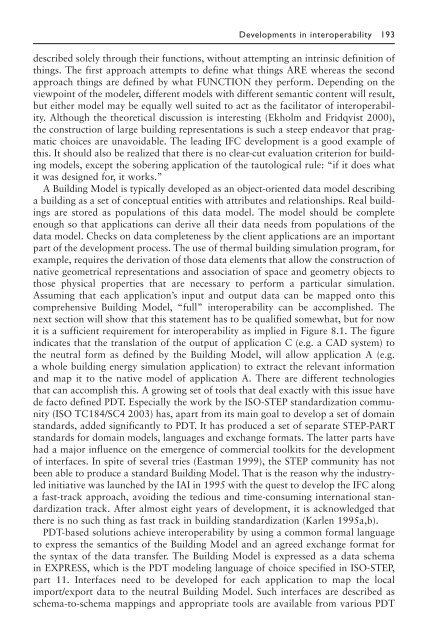Advanced Building Simulation
Advanced Building Simulation
Advanced Building Simulation
You also want an ePaper? Increase the reach of your titles
YUMPU automatically turns print PDFs into web optimized ePapers that Google loves.
Developments in interoperability 193<br />
described solely through their functions, without attempting an intrinsic definition of<br />
things. The first approach attempts to define what things ARE whereas the second<br />
approach things are defined by what FUNCTION they perform. Depending on the<br />
viewpoint of the modeler, different models with different semantic content will result,<br />
but either model may be equally well suited to act as the facilitator of interoperability.<br />
Although the theoretical discussion is interesting (Ekholm and Fridqvist 2000),<br />
the construction of large building representations is such a steep endeavor that pragmatic<br />
choices are unavoidable. The leading IFC development is a good example of<br />
this. It should also be realized that there is no clear-cut evaluation criterion for building<br />
models, except the sobering application of the tautological rule: “if it does what<br />
it was designed for, it works.”<br />
A <strong>Building</strong> Model is typically developed as an object-oriented data model describing<br />
a building as a set of conceptual entities with attributes and relationships. Real buildings<br />
are stored as populations of this data model. The model should be complete<br />
enough so that applications can derive all their data needs from populations of the<br />
data model. Checks on data completeness by the client applications are an important<br />
part of the development process. The use of thermal building simulation program, for<br />
example, requires the derivation of those data elements that allow the construction of<br />
native geometrical representations and association of space and geometry objects to<br />
those physical properties that are necessary to perform a particular simulation.<br />
Assuming that each application’s input and output data can be mapped onto this<br />
comprehensive <strong>Building</strong> Model, “full” interoperability can be accomplished. The<br />
next section will show that this statement has to be qualified somewhat, but for now<br />
it is a sufficient requirement for interoperability as implied in Figure 8.1. The figure<br />
indicates that the translation of the output of application C (e.g. a CAD system) to<br />
the neutral form as defined by the <strong>Building</strong> Model, will allow application A (e.g.<br />
a whole building energy simulation application) to extract the relevant information<br />
and map it to the native model of application A. There are different technologies<br />
that can accomplish this. A growing set of tools that deal exactly with this issue have<br />
de facto defined PDT. Especially the work by the ISO-STEP standardization community<br />
(ISO TC184/SC4 2003) has, apart from its main goal to develop a set of domain<br />
standards, added significantly to PDT. It has produced a set of separate STEP-PART<br />
standards for domain models, languages and exchange formats. The latter parts have<br />
had a major influence on the emergence of commercial toolkits for the development<br />
of interfaces. In spite of several tries (Eastman 1999), the STEP community has not<br />
been able to produce a standard <strong>Building</strong> Model. That is the reason why the industryled<br />
initiative was launched by the IAI in 1995 with the quest to develop the IFC along<br />
a fast-track approach, avoiding the tedious and time-consuming international standardization<br />
track. After almost eight years of development, it is acknowledged that<br />
there is no such thing as fast track in building standardization (Karlen 1995a,b).<br />
PDT-based solutions achieve interoperability by using a common formal language<br />
to express the semantics of the <strong>Building</strong> Model and an agreed exchange format for<br />
the syntax of the data transfer. The <strong>Building</strong> Model is expressed as a data schema<br />
in EXPRESS, which is the PDT modeling language of choice specified in ISO-STEP,<br />
part 11. Interfaces need to be developed for each application to map the local<br />
import/export data to the neutral <strong>Building</strong> Model. Such interfaces are described as<br />
schema-to-schema mappings and appropriate tools are available from various PDT

















